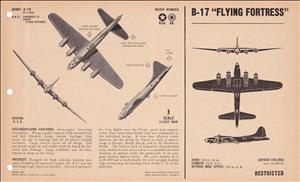On July 23, 1944, hundreds gather at the Hanford Airport to witness the christening of a special airplane. Every employee at the Hanford Engineer Works donated one day’s pay to purchase the airplane, a B-17 bomber, as their contribution to the war effort. The plane is christened “Day’s Pay,” and is presented to the U.S. Army Air Forces.
Sending a Bomber on its Way
As World War II wore on, employees at the Hanford Engineer Works wondered how they could help. Carpenter Max Blanchard is generally credited with coming up with the idea for buying a war plane to send overseas. Shortly after the D-Day landing of June 6, 1944, Blanchard received a letter from his son, who was fighting overseas. The letter was full of praise for the offensive support the troops received from the air. Blanchard knew then that a plane was the right gift for the Army and that it would be appreciated more than anything else. Blanchard told his crew about his idea, and they quickly spread the word.
Soon the whole Hanford Site was enthusiastically supporting the idea of buying the war machine. Over the course of the next month, the payroll department collected a day’s pay from each employee (more than 51,000 people worked at Hanford from 1943 to 1945). The “Give a Bomber” committee held a contest to pick a name for the plane. Eleven people submitted the name “Day’s Pay,” since the campaign was conducted under the slogan “Give a day’s pay and send a bomber on its way.” All employees who contributed to the cause received a certificate acknowledging their “share” of the bomber.
After the money was collected, the Army Air Forces was asked what type of plane it needed. The answer came back quickly -- the B-17 Flying Fortress. The B-17 was huge, measuring 74 feet, 9 inches in length and 103 feet, 9 inches from wing-tip to wing-tip. It could carry 1,700 gallons of fuel on which it could fly about 3,750 miles. The B-17 had awesome fighting power. It was armed with 11 .50-caliber Browning machine guns. It could carry bombs weighing up to 16,000 pounds. It required a crew of 10, including pilot, co-pilot, bombardier, and navigator. The model given to the Army was officially known as the B-17G, which incorporated a number of modifications made to the original design. The cost of the bomber was approximately $300,000.
Dedicating Day's Pay
On July 23, 1944, a Sunday, the dedication celebration began with a military demonstration performed by Company D of the 744th Military Police Detachment. This was followed by singing of the National Anthem, accompanied by the U.S. Army Band and the Hanford Engineer Works Band. After the anthem, Hanford Site commander Lt. Col. Frank T. Matthias and prime contractor Dupont General Manager G. P. Church addressed the crowd. Finally John Hidebrink, chairman of the “Give a Bomber” Committee, presented the bomber to Colonel David Wade, Base Commander at the Walla Walla Army Air Field.
Attention then turned to the airplane itself. Mrs. Katie Belle Harris, whose son had been lost in action in Germany earlier in the year, was given the honors of christening the B-17. She broke a champagne bottle over the nose of the airplane. Under the “Day’s Pay” moniker painted on the nose, the words “Presented to the Army Air Forces as a Result of Cash Contributions by Employees of Hanford Engineer Works,” explained the origin of the plane. There was also a plaque mounted on the inside of the plane. After the christening, Brigadier General James E. Parker, Commanding General of the 4th Air Force in San Francisco, told the Hanford workers how much he appreciated their sacrifice. Major Samuel Grashio, from Spokane, told of atrocities he witnessed inflicted by the Japanese on the survivors of Corregidor. Also on hand, was Captain Jack Wilson of Benton City, who had flown 72 missions over Europe. Lt. Col. Stanford Chester, representing Assistant Secretary of War for Air Robert A. Lovett, promised to let the employees know how the bomber fared in the war. After the speeches, the crowd sang a song about Day’s Pay written for the occasion by Bishop Ruland.
Ready for Action
Then it came time for the B-17 to be taken to its new home of the 8th Army Air Force in England. Members of the Ferry Command boarded the plane, revved it up, and flew away. The plane, escorted by four fighter planes, dipped her wing in salute three times before flying on. Initially, the plane was flown to the Walla Walla Army Air Field. From there it was flown to Kearney, Nebraska, where its first crew took over. The first flight took it to New Hampshire, Labrador, Iceland, and finally to Ireland. The plane would eventually fly more than 60 missions in Germany, bombing oil refineries at Hamburg and an ordnance depot at Dusseldorf, among many other targets. The plane was “injured” a number of times, being hit in the engine, the gas tank, and the nose.
War's End
In July 1945, Day’s Pay was flown back to the United States, initially to Connecticut, then on to Independence Field, Kansas, for storage. In October, Day’s Pay, along with thousands of other planes, was declared excess. In December it was taken to Kingman Field, Arizona, for reduction to scrap. Day's Pay was crunched into scrap on December 4, 1947. A letter was sent to Hanford Engineer Works employees informing them of their airplane's demise.

